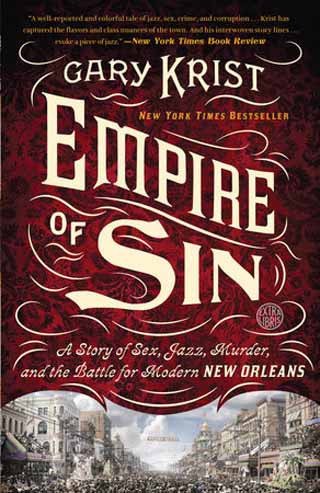

Facebook, I hate to admit, is my water cooler.” “I would love a water cooler to be able to talk with colleagues. That is where experience in fiction writing has helped shape narrative and characters.” He built the book in his screened-in gazebo behind his home in Bethesda, where he writes daily, summer and winter, in longhand because “it slows me down and makes every sentence important.” The gazebo is his “sanctuary,” but it has its drawbacks. “I needed to be selective with the dialogue,” Krist says, “to keep the reader engaged. The book moves forward like a good novel, yet all dialogue is taken from primary sources, none invente d. When the reformers dismantled their creation of isolated vice in an all-out “battle” for final reform, it was Armstrong who wittily gave the eulogy: “After Storyville closed down-the people spreaded out all over the city…so we turned out nice and reformed.” Surprisingly, Louis Armstrong, beloved jazzman and American icon, had deep roots in Storyville, doing errands for the brothel houses and learning his trade on trumpet in the clubs. Tom Anderson, the “mayor” of Storyville, rose politically to enhance his seedy empire of bars, restaurants and part ownership in Josie’s sex palace, the Chateau. Josie Arlington, aka Josie Lobrano, born Mary Deubler, was a brothel entrepreneur. The central figures driving the narrative are all products of the exotic nature of the city, and all thrive in the cultural and economic stew of Storyville. When the legislation passed in 1897, the area boomed with sex, gambling, corruption and jazz, and would forever be known as Storyville after its legislative father. City councilman Alderman Sidney Story proposed that prostitution be illegal everywhere in the city, except within an 18-block area downriver from Canal Street. With the sex trade booming, the proper city fathers decided on reform, and short of reform, to establish an isolation of the brothels and music houses that might give their city a bad reputation and keep capital from being invested for trade and expansion of the city. Storyville is home ground for this history yarn. Bourbon Street now is maybe a hint of what Storyville was like.” “I wanted to feel what it was like 100 years ago and get a sense of what is unique about this city,” he says. To achieve this sense of place, Krist spent as much time as possible in New Orleans, away from his home in Bethesda, Maryland.

It’s a city where anything can happen, and that potential continues to lure tourists to the Crescent City today. It portrays a city that is steamy, sexy, and both foreign and distinctly American at the same time, eerily similar to the New Orleans we knew before Katrina set it on its heels. As the enticing subtitle not so subtly hints, it is a city, a political scene, and an economy that is driven by sex, jazz and murder, all interrelated, all a pure product of time and place. Krist’s latest nonfiction yarn, Empire of Sin, is a well-wrought history of New Orleans in the late-19th and early-20th centuries. “You need the narrative that keeps the general reader engaged. And then I switched to history and found it satisfying in a way that is the same pleasure from writing novels,” says Krist. “I loved the research of the historical novel, nosing around in primary sources to back the fiction. Through an evolution of his interests, he’s become a very eclectic writer. Respected first for his short fiction, Krist ventured out as a novelist, reviewed other authors for major publications and wrote travel journalism, all done with awards to his credit. He’s published three books on the time period: The White Cascade (2007), City of Scoundrels (2012) and now Empire of Sin: A Story of Sex, Jazz, Murder and the Battle for Modern New Orleans. Gary Krist is on a path of writing narrative nonfiction that centers around the Progressive Era-the first decades of the 20th century in America.


 0 kommentar(er)
0 kommentar(er)
